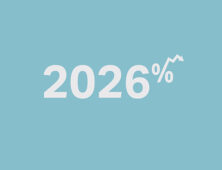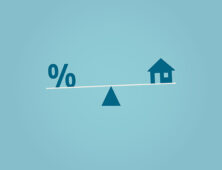Today’s Mortgage Rates in January 2026

Jan 5, 2026

1️⃣ A Housing Market That’s Quietly Turning the Corner
As we enter 2026, economists are rolling out their forecasts for housing and mortgage rates, and the tone has noticeably improved. While risks remain, ranging from policy uncertainty to global instability, the broader outlook is becoming more constructive. After nearly four years of housing headwinds, lower mortgage rates are finally beginning to influence buyer behavior.
Pending home sales are now at their highest level in roughly three years, a strong signal that buyers are adjusting to today’s rate environment rather than waiting on the sidelines. This matters as we head into the traditionally stronger spring buying season, suggesting demand is healing even before rates return to what many would consider “normal.”
2️⃣ Labor Market Cracks Are Becoming Harder to Ignore
The period immediately following the holidays is historically when employers are more willing to make staffing cuts, and the data is beginning to reflect that reality. Continuing unemployment claims have climbed to multi-year highs, reinforcing the idea that displaced workers are taking longer to find new jobs. This gradual softening in the labor market is important for mortgage rates. A cooling employment picture helps limit upward pressure on rates and keeps the door open for further improvement, even if the path lower remains uneven.
3️⃣ Jobs Report Will Set the Near-Term Tone for Rates
Friday’s payroll report will be a key driver for mortgage rates in the days ahead. Seasonal hiring is likely to add headline strength, which is why full-time employment will be the metric worth watching most closely. The unemployment rate will also be under scrutiny after rising to 4.6% last month, a level not seen since the pandemic era. Any confirmation that labor market momentum is continuing to slow would be welcomed by the bond market and could help fuel additional housing demand as buyers gain confidence that rates are trending in the right direction.
💡Rates & Market Outlook
Bottom Line – Lock or Float?
Mortgage rates have remained stuck in a relatively tight range for several months. With the 10-Year Treasury yield sitting near multi-month highs, modest near-term improvement is possible. That said, elevated geopolitical risk keeps volatility firmly in play. For borrowers with upcoming closings, a cautious locking bias remains appropriate, while those with longer timelines may selectively float, but only with a clear risk tolerance and close monitoring.
Dec 29, 2025

1️⃣ Rate Cuts Are Fewer — But Spreads May Do the Heavy Lifting
Market expectations for 2026 have shifted meaningfully. Investors now anticipate just two quarter-point rate cuts next year, while the Federal Reserve is signaling only one. This is a notable change from earlier in 2025, when many believed the Fed would need to cut more aggressively in 2026 to support a slowing economy. As a result, expectations for meaningful declines in mortgage rates have been dialed back, with most forecasts now calling for only modest improvement.
That said, there is a more constructive development beneath the surface. The spread between the 10-year Treasury yield and average mortgage rates has narrowed materially. After spending an extended period roughly 1% wider than normal, today’s spread is now only about 35 basis points above historical norms. If spreads continue to normalize, mortgage rates could improve by a similar margin, even without major Fed action. While that may not feel dramatic, a 30–35 basis-point move would provide real, tangible relief for homebuyers by lowering the true cost of homeownership.
2️⃣ Inflation Data Looks Better — But Confidence Is Still Lacking
Recent inflation readings have appeared encouraging at first glance, but economists remain cautious about how much confidence to place in them. Delays in key pricing data, revisions to seasonal adjustments, and incomplete cost components have created uncertainty around whether inflation is truly cooling or simply being temporarily masked by data distortions.
Markets are increasingly hesitant to react aggressively to any single inflation report, especially when the inputs behind the numbers are still being reworked or clarified. Until inflation data becomes more timely, consistent, and clearly trend-based, investors are unlikely to price in faster or deeper rate cuts. This uncertainty helps explain why mortgage rates have struggled to break meaningfully lower, even when headline inflation appears to be moving in the right direction.
3️⃣ Deficit Spending: The Hidden Driver of High Mortgage Rates
Mortgage rates remain elevated for a reason that rarely makes headlines: government borrowing. Persistent deficit spending forces the U.S. Treasury to issue massive amounts of new debt, and investors demand higher yields to absorb it. Those higher Treasury yields flow directly into long-term interest rates, including mortgages, regardless of what the Fed does with short-term policy rates.
This dynamic helps explain why mortgage rates have stayed stubbornly high even as economic growth slows and rate cuts are discussed. Weak demand at recent Treasury auctions has pushed yields higher – not because the economy is strong, but because lenders want more compensation to finance a government running large and growing deficits. Looking ahead, budget projections already show deficit spending expected to increase in 2026 compared to 2025, meaning heavy Treasury issuance, and upward pressure on mortgage rates, is likely to continue. Until government spending meaningfully slows, sustained relief in mortgage rates will remain difficult, even if the Fed cuts.
💡Rates & Market Outlook
Bottom Line — Locking Bias
Mortgage rates continue to trade within a tight range. Without clear, credible evidence of sustained inflation cooling or a material weakening in the U.S. economy, there is limited incentive to float. Borrowers with near-term timelines should strongly consider locking, while those with flexibility should remain cautious and selective.
Dec 15, 2025

1️⃣ Markets Are Watching the Future of the Federal Reserve Carefully
Financial markets have grown increasingly sensitive to speculation around who may succeed Jerome Powell when his term as Fed Chair ends next May. While no decision has been finalized, investors are focused less on personalities and more on the broader concern of Fed independence. The central issue is whether future monetary policy decisions remain grounded in economic data rather than short-term objectives.
History shows that if interest rates are held artificially low and inflation pressures reaccelerate, market-driven rates, including mortgage rates, tend to move higher, not lower. A steady, data-dependent Fed remains critical for housing stability and long-term economic growth, which is why markets react quickly when that balance appears at risk.
2️⃣ The Fed Cuts Again and Signals a Shift in Policy Support
Last Wednesday, the Federal Reserve delivered its third consecutive quarter-point rate cut, bringing the Fed Funds range down to 3.5%–3.75%. While the rate cut itself was widely expected, the bigger development came from the Fed’s decision to restart balance-sheet expansion.
Beginning last Friday, the Fed started purchasing $40 billion in short-term Treasury bills each month, effectively reintroducing a form of quantitative easing. This move helps absorb the growing supply of government debt and reduces pressure on private investors to fund federal deficits. In practical terms, this added demand for Treasuries provides support for lower interest rates across the yield curve, including mortgage rates, at least in the near term.
3️⃣ A Highly Anticipated Labor Report Could Set the Tone
On Tuesday, we will finally receive the delayed Bureau of Labor Statistics employment report for November, the first official labor data release since September. With private-sector reports, such as ADP, showing notable weakness, expectations are modest, with job growth projected around 35,000 and unemployment holding near 4.4%.
Because of the long gap in official data, this report carries more weight than usual in shaping how markets assess the health of the economy. Evidence of slowing employment would likely reinforce downward pressure on rates, while a surprise rebound in hiring could push rates higher again.
💡Rates & Market Outlook
Bottom Line
There has been little incentive to float rates over the past several weeks. Given the balance of risks and upcoming data, we continue to maintain a locking bias.
Dec 08, 2025

1️⃣ Private Payrolls Turn Negative
The November ADP report delivered another blow to the narrative that the labor market remains resilient. Private employers unexpectedly shed 32,000 jobs last month, marking one of the first outright declines we have seen outside of the pandemic shock. While a single month does not confirm a trend, this drop follows a steady cooling in hiring throughout the fall.
What concerns me most is not just the negative print but the shift in hiring behavior beneath the surface. Businesses are clearly becoming more cautious, pulling back before the harder data from the Bureau of Labor Statistics even arrives. When employers start trimming staff before the official data confirms weakness, it often signals that a slowdown is already underway.
2️⃣ Layoff Announcements Hit Pandemic-Era Levels
Reinforcing this point, layoff announcements have now crossed 1.1 million for the year—the highest level since 2020. That comparison alone tells you how dramatically the landscape has changed. Companies typically announce layoffs months before those job losses show up in the unemployment rate, which means the true softness in the labor market has yet to be fully reflected in the economic data the Fed relies on. The combination of falling private payrolls and a surge in planned layoffs suggests the labor market may be moving from “cooling” to “contracting,” and historically, this is the phase where financial markets start to question whether the Fed has held rates too high for too long.
3️⃣ Fed Expected to Cut—But Tone Remains the Wildcard
That brings us to Wednesday’s Fed meeting, where a quarter-percent rate cut is widely expected. While the cut itself is not likely to surprise anyone, the tone that follows will be what matters most. After October’s cut, Chairman Powell signaled discomfort with easing too quickly, and we should expect more of the same. The Fed is walking a tightrope—acknowledging weakening data without encouraging the markets to assume a rapid series of cuts. The updated Dot Plot, which shows each member’s expectations for the path of rates, will be closely watched.
If the median forecast for 2026 cuts moves lower again, that would be unwelcome news for mortgage rates, which have already climbed at least a quarter percent in recent weeks. Markets tend to trade ahead of the Fed, and a more hawkish Dot Plot could easily spark another jump in yields.
💡Rates & Market Outlook
Floating into a Fed meeting is always a high-risk strategy, and this week is no exception. With mortgage rates already drifting higher and the potential for a hawkish message on Wednesday, the safe and sensible play remains to lock before the announcement.
Dec 01, 2025

1️⃣ Consumer Confidence Falls To Lowest Level Since April
Consumer confidence just slipped to its lowest level since April, and the story behind the headline is what matters most. For the first time in a long while, Americans are openly worried about the job market.
This shift in sentiment is important because confidence often turns before the economic data does. When households begin to fear layoffs, they immediately tighten spending, delay major purchases, and scale back on financial commitments. That mindset alone can slow the economy, and we’re seeing early signs of that happening now. With housing already strained by affordability pressures, a nervous consumer becomes another headwind for the real estate market.
2️⃣ Payroll Data Follows
The concern is reinforced by private payroll data showing losses accelerating over the past four weeks. ADP is not perfect, but when its trend lines follow the same direction as consumer behavior, the signal becomes difficult to ignore.
What makes this moment unusual is that we still don’t have official labor data from the Bureau of Labor Statistics due to the government shutdown. The Fed, investors, and analysts are all trying to assess economic health without the single most important data source they typically rely on.
If BLS data eventually confirms deterioration in the labor market, it will reshape expectations for early 2026 and could push the Fed into a more aggressive easing cycle than originally anticipated.
3️⃣ Next Wednesday, the Fed Will Announce its Final Interest Rate Decision of 2025.
After weeks of speeches hinting at a willingness to cut, markets now assign roughly an eighty-five percent chance that we get one more reduction this year. The challenge is that the Fed must make this call without knowing where unemployment truly stands.
That leaves Friday’s PCE inflation report as their most meaningful guide. This is the Fed’s preferred inflation gauge, and its trajectory will likely determine not just December’s decision, but the tone the Fed sets for 2026. If inflation softens, the Fed can cut confidently and potentially open the door to additional easing early next year. If inflation stalls, the path becomes far less certain.
💡Rates & Market Outlook
Mortgage rates remain stuck in a tight holding pattern. The 10-Year Treasury yield continues to meet resistance every time it approaches the critical four percent threshold. Until that level is broken decisively, rate improvements will be slow and fragile. For now, the advantage remains with locking rather than floating, unless Friday’s data finally gives the bond market the push it has been waiting for.
Nov 24, 2025

1️⃣ The Market’s “Great Divergence”: Why Rates Are Improving Even as Job Reports Show Gains
Last week gave us one of those moments where the headlines and the markets were telling two very different stories. The official BLS report showed job gains of 119,000. If that were the full picture, we’d expect rates to be moving higher. Instead, rates improved. And there’s a good reason for that.
The bond market has quietly stopped trusting the monthly BLS report as the primary indicator of what’s really happening in the labor market. After months of massive revisions, seasonal adjustments that don’t make much sense, and a data gap created by the government shutdown, investors are turning to private, high-frequency data sources that paint a very different picture. ADP, Homebase, Indeed — all of them are showing a job market that is meaningfully softer than the official numbers imply.
From the market’s point of view, the slowdown is already here — the BLS just hasn’t caught up yet. That’s why we’re seeing rates drift lower even while the headlines say employment is holding strong. The bond market is choosing to believe the real-time data over the lagging government reports.
For homebuyers, this creates small windows where rates dip before the broader narrative catches up. Those who wait until the data “officially” confirms a slowdown are usually too late. The opportunity shows up first in the bond market, and that’s exactly what we’re seeing right now.
2️⃣ CPI Report Cancelled: A Strange Move With Big Implications
The BLS made an unusual announcement on Friday: they’re cancelling the release of the October CPI report. Their explanation is that the government shutdown prevented them from retroactively collecting enough data to publish numbers they trust. Whether that’s fully true or not, this is something we almost never see — especially heading into a Fed meeting.
What’s interesting is how the market reacted. Instead of pushing rates higher, bond yields actually improved. Investors already believe that non-tariff related inflation is trending lower, and they’re relying on private-sector data instead — everything from shipping costs to used-car auctions to apartment vacancy rates. All of it points to the same conclusion: inflation is easing.
The real impact of the missing CPI isn’t the data itself. It’s that the Fed now goes into its meeting without the report it normally leans on to justify policy decisions. And markets are taking that as a sign the Fed has even more room to soften its stance. That’s why rates improved on the news instead of selling off.
3️⃣ Existing Home Sales: The “Locked-In” Homeowner Story
Existing home sales remain at extremely low levels, and the reason is simple: most homeowners can’t afford to buy the home they’re already living in. Roughly two-thirds of all U.S. mortgages have a rate under 4%. Many are in the 2s and 3s. If these same homeowners had to buy their homes today — with today’s prices and today’s interest rates — a large percentage would not qualify under standard guidelines. And even those who could qualify often couldn’t comfortably make the payment.
That’s the story behind the inventory shortage. Unless someone is forced to move — job change, divorce, estate sale — homeowners are staying put. They’re not choosing stability; they’re locked into it. And until rates come down enough to re-open affordability, this part of the market will remain frozen.
💡Rates & Market Outlook
Mortgage rates continue to be fairly stable, fluctuating roughly 1/8% in the past month. Unless yields on the 10-Year Treasury Note break below 4%, there is little incentive to float in the near term.
Nov 17, 2025

1️⃣ The Viral “50-Year Mortgage” Idea That Isn’t Likely to Happen
Last week social media erupted over President Trump’s Truth Social post hinting that he intends to become the first president to introduce a 50-year mortgage. The idea spread like wildfire online, with supporters cheering the concept as a way to bring monthly payments down and make homeownership more affordable again. But as the excitement cooled, something interesting happened—many of Trump’s own supporters started raising red flags.
Stretching a home loan out over 50 years dramatically reduces the payment today, yes, but it also traps borrowers in a nearly interest-only trajectory for decades. More importantly, under today’s mortgage framework, a 50-year loan doesn’t qualify as a QM (Qualified Mortgage), which legally caps amortization at 30 years. Reversing that rule would take regulatory changes that do not move quickly. Even if a future administration pushes for it aggressively, the timeline is far longer than the headlines suggest.
The viral hype made for entertaining political theater, but the reality beneath it is slower, more technical, and far less likely to materialize. For now, the 50-year mortgage remains a talking point—not a product.
2️⃣ The Supreme Court Tariff Case That Could Reshape Future Mortgage Rates
While most of the public was busy debating mortgage lengths, the financial world was glued to a much more consequential storyline: the Supreme Court has begun reviewing the legality of President Trump’s sweeping tariff framework on imported goods. This is one of those rare moments when an issue outside the mortgage world directly threatens the foundation of how interest rates behave.
Here’s the unusual dynamic: Tariffs have been one of the biggest sources of inflation over the past year—ironically the very inflation that has kept the Federal Reserve from cutting interest rates deeper and faster. But at the same time, tariffs have generated an enormous amount of federal revenue, partially offsetting deficit spending that would otherwise require even more Treasury borrowing.
If the Supreme Court rules the tariffs illegal, two things happen at once: inflation may cool, giving the Fed room to cut rates… but the government suddenly loses a massive income source. Without that tariff money, the U.S. would immediately have to finance even more debt by issuing additional Treasuries. More Treasuries = higher required yields = upward pressure on mortgage rates.
Most analysts are talking about the inflation angle. Almost no one is talking about the deficit angle. In the long run, that might matter more. Without offsetting tax increases—which are politically dead on arrival after this year’s tax-cut bill—rates could rise even if inflation falls. This is the rare scenario where “good news” on inflation might still mean higher mortgage rates.
3️⃣ The “Portable Mortgage” Proposal and the Real Supply Problem We Still Aren’t Solving
Meanwhile, a second proposal from the Trump Administration is gaining momentum: the idea of a “portable mortgage.” This would allow a homeowner with a low interest rate to sell their home and transfer that existing loan—rate and all—to a new property. The logic is simple: millions of Americans are locked into their homes because moving means trading a 3% rate for a 7%+ rate. Free the mortgage, free the homeowner.
If implemented, portable mortgages would indeed unlock a wave of listings. There would be more homes for sale, more families upgrading or downsizing, and more movement across the entire housing market. But here’s the deeper truth: portable mortgages do not solve the real issue that’s choking the system. Every portable mortgage transaction is one home for sale tied to one home being purchased. Supply increases temporarily, but total housing stock does not.
Affordability problems are always, at their core, supply problems. Housing inflation is a supply problem. And portable mortgages—no matter how interesting or helpful—do not add new homes to the market. Until the nation builds far more units than it currently is, every policy “solution” is simply rearranging the same limited inventory.
It’s a clever idea. But it’s not the cure.
💡Rates & Market Outlook
Bottom Line – Locking Bias Mortgage rates continue trending higher as markets brace for uncertainty around tariffs, inflation, and supply-side constraints. In the short term, we maintain a locking bias.
Nov 10, 2025

1️⃣ The Labor Market Is Showing Real Strain
The job market is beginning to lose steam. ADP reported just 42,000 private-sector jobs added in October—better than the 24,000 expected, but still far from healthy growth. What’s more, that figure doesn’t account for the thousands of federal employees sidelined by the ongoing government shutdown. Because of the shutdown, the Bureau of Labor Statistics hasn’t released its usual employment data, leaving analysts to rely on private sources like ADP to gauge momentum.
Once federal workers return and official numbers are published, we’ll get a clearer look at just how much damage has been done. Early indications suggest the slowdown is deeper than most realize, which could influence the Federal Reserve’s next policy steps. Since employment is one of the Fed’s most important indicators, weaker labor data increases the odds of a more dovish stance in the coming months.
2️⃣ Home Prices Take a Small Step Back
After months of holding strong, national home prices finally slipped in September. The Cotality Home Price Index reported a 0.2% monthly decline, though prices remain 1.2% higher than a year ago. That modest pullback may actually help relieve some affordability pressure after the run-up in recent years.
Looking forward, Cotality projects that values will rise roughly 4.1% over the next twelve months, likely based on expectations that mortgage rates will decline and awaken pent-up demand. Across the country, buyers who have been sitting on the sidelines are watching for even small rate improvements that could bring monthly payments within reach. When that happens, demand could rebound quickly—particularly in markets where inventory remains tight. In short, housing is catching its breath, not collapsing.
3️⃣ A Growing Divide Beneath the Surface
Beneath the headlines of market rallies and “resilient” economic growth lies a widening gap in financial wellbeing. The wealthiest 10% of households now account for nearly half of all U.S. spending, buoyed by a record-setting stock market and robust investment gains. Meanwhile, middle- and lower-income families are tightening budgets as wage growth stalls and inflation hovers around 3%.
Many Americans are once again choosing between bills, groceries, and car payments—a sign of growing strain that can’t be seen in stock charts.
Economists warn that this imbalance makes the economy more fragile, like a Jenga tower built too high on one side. As long as spending is concentrated among the wealthy, even a small slowdown at the top could ripple through the rest of the system, increasing the risk of recession.
💡Rates & Market Outlook
Bottom Line – Overall Locking Bias
Mortgage rates remain volatile but range-bound, moving up or down slightly from day to day without a clear breakout. The weakening labor market points toward eventual rate relief, but near-term uncertainty keeps risks on the table. For borrowers closing soon, locking remains the safer choice. Those with longer timelines may benefit from patience, but the window for improvement could open and close quickly in this unpredictable market.
Nov 3, 2025

1️⃣ Mortgage Rates React to the Fed’s Cut
Last week’s Federal Reserve rate announcement put an end to the short term downward trend of mortgage rates, sending rates higher immediately following Fed Chairman Powell’s comments in his prepared speech. While the Fed’s cut was intended to support a slowing economy, the bond market was focused on the hesitant tone from Powell, suggesting that a December rate cut is not a certainty.
This tug-of-war between optimism and concern reflects the delicate balance we’re in right now. On one hand, the Fed’s easing is welcome news long term for homebuyers and homeowners looking to refinance, as it helps improve affordability. On the other, the very reason for the Fed’s rate cut—slowing growth—suggests the economy could be losing momentum, which brings its own risks for the housing market. For now, rates appear to have found a temporary ceiling, but if that barrier is broken, we could see them take another step higher in the days ahead.
2️⃣ Confidence Falters as Consumers Brace for Slower Times
Adding to the concern, consumer confidence has now fallen for the third straight month. The latest data from the Conference Board shows that optimism about the future is fading, with Americans growing more worried about their jobs, income prospects, and the overall economy. While the current conditions index—how people feel about the present—ticked slightly higher, expectations for the next six months dropped to their lowest level since early summer.
It’s clear that consumers are beginning to feel the pinch of a cooling labor market and persistent inflation, now hovering near 3%. Many say they believe the economy has already slipped into recession, even if official data doesn’t yet confirm it. For the housing market, this type of sentiment matters deeply. When people are uneasy about job security or future earnings, big financial commitments—like buying a home—tend to get delayed. Builders and real estate agents are already reporting more cautious buyers, and lenders are watching credit quality closely.
The silver lining is that weaker confidence could prompt the Fed to remain supportive for longer, potentially keeping mortgage rates from spiking. But for now, the emotional temperature of the consumer is telling us that the road ahead could be bumpy.
3️⃣ The Fed Ends QT
The big news this week came straight from the Federal Reserve. At its October 29 meeting, the Fed officially announced that its balance-sheet reduction program—known as Quantitative Tightening, or QT—will come to an end on December 1, 2025. This marks a dramatic shift in monetary policy after more than three years of balance-sheet contraction that removed roughly $2.2 trillion in liquidity from the financial system.
What happens next is even more significant. Beginning in December, the Fed will transition into a neutral maintenance phase and reinvest all principal payments from maturing Treasury and mortgage-backed securities (MBS). Those reinvestments will primarily flow into short-term Treasury bills, which will help stabilize money markets and inject liquidity back into the system.
In short, the Fed is signaling a move from contraction to expansion—effectively paving the way toward a new round of Quantitative Easing (QE). When QE begins, the Fed buys longer-term bonds to lower borrowing costs and stimulate economic growth. For the mortgage market, that typically means downward pressure on long-term rates, including mortgage rates. This is one of the most market-friendly announcements we’ve seen in years and could prove to be a turning point for housing affordability heading into 2026.
💡Rates & Market Outlook
Bottom Line – Maintaining Short Term Locking Bias
In this environment, timing is everything. For those who need to close soon, it makes sense to lock in a rate rather than risk potential volatility. Rates have already improved significantly from their highs earlier this year, and waiting for perfection could mean missing the current window of opportunity.
For borrowers who have more time before their closing date or are still shopping, cautiously floating could make sense—just know that the margin for improvement may be narrowing.
Oct 27, 2025

1️⃣ Inflation Offers a Bit of Relief, but the Fight Isn’t Over
Friday’s Consumer Price Index report gave both Wall Street and Main Street a small sigh of relief. Inflation rose just 0.3% in September—slightly below expectations—and while the annual rate inched up from 2.9% to 3.0%, it was still better than the 3.1% economists had anticipated. When volatile food and energy prices are removed, the “core” rate of inflation rose just 0.2% for the month, bringing the year-over-year number down to 3%.
This may not sound like much, but these small moves carry big weight. The report shows that underlying price pressures continue to trend lower, especially in categories like rent, travel, and services. That’s encouraging news for the Federal Reserve, which has spent more than two years trying to tame inflation back to its 2% target. For consumers, it’s a sign that the worst of the price surges may be behind us. However, tariff-related inflation remains a concern, and as long as those trade pressures linger, there’s still a ceiling on how low prices—and ultimately rates—can go.
2️⃣ All Eyes on the Fed This Week
The next big event comes Wednesday when the Federal Reserve announces its latest policy decision. Virtually everyone expects a quarter-percent rate cut, and those odds are already fully baked into current mortgage pricing. What’s more interesting is that Friday’s tame inflation report has increased the likelihood of another cut in December to around 80%.
While most of the focus will be on whether the Fed follows through with the cut, the bigger story for mortgage rates lies in what happens with the Fed’s balance sheet. Chairman Jerome Powell has hinted that the era of Quantitative Tightening—the process of shrinking the Fed’s balance sheet by letting bonds mature—is nearing an end. If the Fed confirms that plan, it would mean as much as $35 billion per month flowing back into the bond market. That’s a powerful force that could help ease longer-term interest rates, including mortgage rates, over time.
Of course, history reminds us that Fed announcements are unpredictable. Even when the Fed cuts rates, mortgage rates don’t always follow immediately. That’s because mortgage pricing is driven by long-term bond yields and inflation expectations, not just the Fed Funds Rate. Still, the combination of a cooling inflation trend and a Fed preparing to inject liquidity into the bond market sets the stage for potential improvement ahead.
3️⃣ The Shutdown Drags On—Now the Second Longest in U.S. History
Today marks Day 27 of the federal government shutdown—now officially the second longest in U.S. history, trailing only the 35-day shutdown that stretched from late 2018 into early 2019. Roughly 750,000 federal workers are currently on furlough, with many agencies operating on skeleton crews. Beyond the political drama, the shutdown’s economic toll is beginning to mount. If it continues into November, programs such as food assistance could be disrupted, putting roughly one in eight Americans at risk of losing vital benefits.
Markets are watching this closely, as prolonged shutdowns can chip away at economic growth and dent consumer confidence. Ironically, the slowdown that comes from a government shutdown could help keep inflation in check—but at the cost of financial stability for millions of families. For now, the impasse centers around healthcare policy and the cost of private market insurance, but pressure is building to reach a deal before more households feel the pain.
💡Rates & Market Outlook
Bottom Line – Maintaining a Locking Bias
Meanwhile, the 10-Year Treasury yield continues to test the critical 4% level. Mortgage rates tend to move in the same direction as Treasury yields, so a decisive break below 4% could signal the start of a sustained improvement in mortgage pricing. Until that happens, however, any rally should be approached cautiously.
While we’re seeing encouraging signs that inflation is cooling and that the Fed is preparing to support the bond market, there’s still plenty of uncertainty ahead. Historically, Fed announcements have not been friendly to mortgage bonds, and the ongoing government shutdown adds another layer of volatility. If you’re set to close soon, locking your rate remains the safer play. For those with more time before closing, there’s potential for improvement, but be ready to move quickly if markets turn.
Oct 20, 2025

1️⃣ Fed signals the end of Quantitative Tightening is near
The biggest headline of the week came from Fed Chair Jerome Powell, who suggested that the Fed’s long-running Quantitative Tightening program may soon come to an end. This marks a major shift in policy. In plain terms, it means the Fed will stop reducing the size of its balance sheet — a move that will translate to billions of additional dollars each month flowing back into the bond market.
While most of those purchases will likely be in U.S. Treasuries, the added demand will still help support overall bond prices and soften yields across the board, including for mortgage-backed securities. That’s good news for mortgage rates, which often benefit when the Fed is adding liquidity to the bond market.
After nearly three years of aggressive tightening, this pivot represents a clear signal that the Fed believes its work is largely done. Non-tariff driven inflation has cooled, the labor market has shown signs of balance, and policymakers are preparing to shift from fighting inflation to maintaining stability. Markets quickly responded, with Treasury yields easing and investors beginning to price in the potential for rate cuts in the year ahead.
2️⃣Bank worries and China tensions stir up October volatility
Even as optimism built around the Fed’s message, markets were rattled by renewed concerns over the health of regional banks (including Utah’s Zions Bank) and the ongoing trade battle with China. Several regional lenders reported higher losses tied to commercial real estate loans, raising questions about credit exposure and risk management. Meanwhile, tensions between Washington and Beijing flared again as both sides discussed new tariffs and export restrictions on critical materials.
Together, these stories created another week of volatility — something October is famous for. Investors toggled between hope for lower rates and fear of what rising global tension could mean for economic growth. Still, the overall picture remains constructive. Inflation continues to cool, the Fed is signaling an end to tightening, and the economy appears to be slowing in a controlled way.
Volatility may persist, but the foundation for lower rates is forming beneath the surface.
3️⃣Ten-Year Treasury dips below 4%, raising hope for lower mortgage rates
The most encouraging news for borrowers came from the bond market. The yield on the 10-Year Treasury briefly dipped below 4% last week — a key psychological level that often attracts investors and sparks optimism for lower mortgage rates.
Although mortgage rates don’t move perfectly with the 10-Year, they generally follow the same direction. Historically, mortgage rates have averaged just under 2% above the yield on the 10-Year Treasury. In recent years, that spread widened to nearly 3% as lenders priced in added risk. The good news is that the spread has been narrowing steadily throughout 2025, now sitting near 2.25%.
If yields continue to edge lower and spreads tighten further, we could see mortgage rates fall faster than the bond market alone would suggest. It’s too early to call it a trend, but there’s real momentum building for a meaningful step down in rates in the months ahead.
💡Rates & Market Outlook
Bottom Line – If Floating, do so Only with One Hand on the Lock Trigger
With the Fed preparing to end Quantitative Tightening and the 10-Year Treasury testing the 4% level, conditions are improving for lower rates. However, yields still face strong support at current levels, and markets remain highly sensitive to economic data and global headlines.
For loans closing soon, if you are risk adverse, it remains wise to lock and protect against short-term reversals. For those with more time, the outlook continues to brighten. The bond market is beginning to feel the early effects of a shift in Fed policy — and that could soon translate into better mortgage rates ahead.



